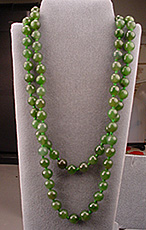
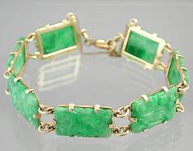
Although "jade" has been in use for a variety of utilitarian and artistic purposes for over 7000 years, it was only in 1863 that a gemological distinction was made between the two different species commonly given this name. Jadeite, an aggregate of granular pyroxenes, actually is not related to nephrite, an aggregate of fibrous amphiboles. The fact that they occur in the same color and translucency range, are both incredibly tough, and were traditionally used for the same purposes, along with their superficially similar appearance has led to the odd consequence of having two quite different gems with the same name.
Even though marketers, jewelers and the public continue to refer to both gems as jade, more properly the species should be used as, or at least included in, the name: so either nephrite (or nephrite jade) or jadeite (or jadeite jade) is the preferred terminology.
Nephrite is, then, a calcium-magnesium silicate that varies from translucent to opaque, and from shades of green, through browns and yellows to greys and near whites as it varies in the proportion of the amphibole minerals in its makeup. The darker pieces are mostly made up of iron rich (up to 5% iron content) actinolites, the lighter pieces contain more of the magnesium rich tremolites. Pieces may be mottled or banded in color, and black inclusions are common. Typically the iron induced green colors of nephrite are dulled somewhat by brown tones in comparison to the more highly saturated chromium derived hues of green jadeite.


As nephrite jade is, by definition, a mixture of amphiboles with an interlocking microcrystalline structure, pure actinolite or pure tremolite minerals, therefore are not jade. Actinolite sometimes occurs in a chatoyant form, though, which is often sold under the misnomer "cat'seye jade".

Nephrite is mined in many locales, ranging from New Zealand, Siberia and South Korea, to the USA (Wyoming and California primarily), but the largest deposits, by far, come from British Columbia. These Canadian sites often yield huge boulders, frequently covered with a brown rind of oxidized iron. The finest of this material is trademarked as "Polar Jade" and is of a translucent and rich green color seen in very few other specimens of nephrite. Large scale mining began there in 1995.



The wide distribution and useful properties of nephrite account for the world-wide useage of this stone by ancient cultures. Archeologists have retrieved tools and artworks made of nephrite in locations from Switzerland to New Zealand, the Americas, and Asia.
This stone was valued highly by these people as it it could be used for tough knives, spears, hammers and axes, yet could be carved into exquisitely delicate bowls, figurines, masks and jewelry items. Its legendary toughness is a consequence of the interlocking "felted" nature of the tiny fibrous crystals within. Until the advent of steel, nephrite was the strongest available material for tools and weapons, less brittle and better able to keep a sharp edge than any other stone, or than copper, bronze or iron.
Although nephrite artifacts date as far back as 3500 BCE in Europe, there is evidence documenting its use in China for more than 7000 years. The nephrite around which the Chinese built many aspects of their culture was obtained, technically, from Turkestan, a region not incorporated into China politically until after World War II. Known from legend as "The Stone of Heaven", nephrite attained a position in the religious and cultural life of these people that has not been seen with any other natural substance in any other time or culture.
The two pieces shown below are contemporary Chinese nephrite carvings. The curled "dragon" is cut from "tomb jade" which has long been buried underground, and is stained and somewhat corroded with iron minerals, it is done in a faithful copy of a style from the Han Dynasty period, circa 200 BCE. The pure white citrus blossom carving is from Xinjiang Province (the traditional collection site of rare white nephrite) and shows the purity of color, translucence and desirable "greasy" luster of the best ancient materials.
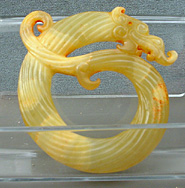
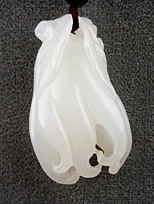
For nearly all of the 7000+ year history of China's love of jade, it has been nephrite that was the object of affection and reverence. Only in 1784 was jadeite imported in quantity to China to begin its rapid "takeover" in popularity.
The Maori of New Zealand have had as initimate a relationship with nephrite as the Chinese, if not nearly so long a one. Known as "pounamu" or greenstone it was used for weapons, tools and ornamental and religious objects. Some of the most advanced nephrite carving in the world has been done in recent years by New Zealanders using some of the superb local material. The piece below is a sublime example from the hand of Donn Salt.
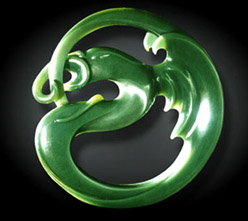
The USA produces three notable types of nephrite: black with magnetite inclusions, and "Vonsen Blue" jade, both from California, and the green to black material from Wyoming.
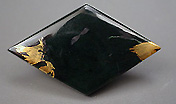

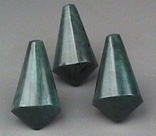
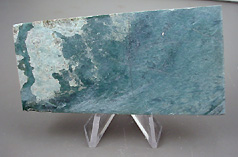
The name "nephrite" derives from the early belief that carrying talismans of certain green stones would cure or ward off ailments of the kidneys, although ironically, scholars have found that jadeite was actually the stone so used.
One of the most widely available of gems, nonetheless nephrite has been extensively imitated. Natural simulants often presented (knowingly or not) as nephrite include bowenite, Vesuvianite, serpentine, aventurine, amazonite, verd antique and massive grossular garnet.


Nephrite is sometimes enhanced by dyeing, heating and waxing, although the prevalence of such treatments is not nearly as high as with jadeite gems. A man-made glass imitation called "metajade" or "imori stone" is sometimes found in the market, although true synthetic nephrite is not.
Nephrite gems or art objects require no special care, they can be safely cleaned in ultrasonic baths and steamers. Traditionally nephrite gems are given in honor of the 12th wedding anniversary.
In general, per carat values for nephrite gems are modest. The highest prices in jewelry pieces go to those with the greatest translucence and most pleasing colors or patterns or those that have been artistically carved. In some cases collectors pay higher prices for gems mined in specific locations, or those cut by certain artists. In art objects, the delicacy of the carving and antiquity of the piece are the prime determiners of value.